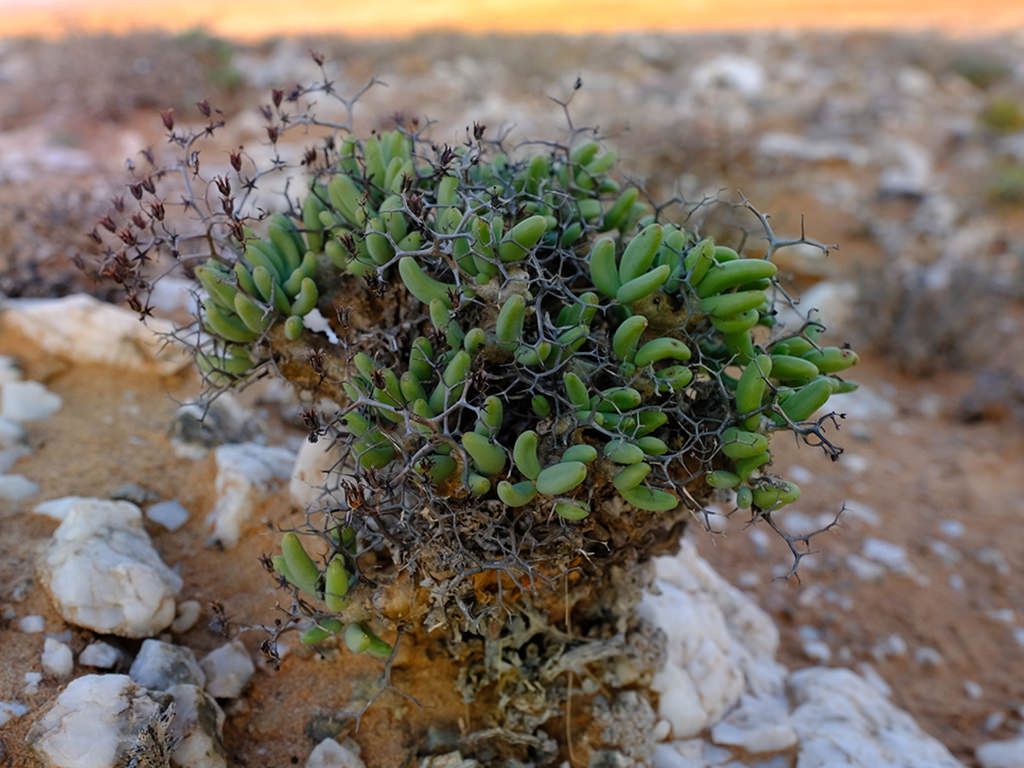Scientific Name
Tylecodon reticulatus (L.fil.) Toelken
Common Name(s)
Oukoe Butterbush, Thorny Butterbush
Synonym(s)
Cotyledon reticulata, Cotyledon parvula, Tylecodon reticulatus subsp. reticulatus
Scientific Classification
Family: Crassulaceae
Subfamily: Kalanchoideae
Genus: Tylecodon
Origin
This species is native to Namibia and South Africa. It grows on stony slopes or loamy flats from southern Namibia to Little Karoo and Klipplaat in South Africa.
Description
Tylecodon reticulatus is a small succulent shrub with a usually solitary, basally swollen stem with a rounded sparingly branched crown up to 12 inches (30 cm) in diameter. It grows up to 15 inches (38 cm) tall. The main stem is up to 2.4 inches (6 cm) in diameter. The stems are covered with yellowish-brown peeling bark or sometimes with short circular phyllopodia on young branches. Leaves are erect to ascending, linear, oblanceolate, or rarely obovate, up to 2 inches (5 cm) long and up to 0.4 inches (1 cm) wide. They are glabrous to glandular-hairy, yellowish-green, bluish-green to heavily pink-tinged, crowded at the branch tips. Flowers are tubular or swollen at base, yellowish-green, tinged brown, and appear in finely branched thyrses with many dichasia in late spring and summer after the leaves start to drop off. The flower stems persist after flowering, forming a dense reticulate crown above branches and leaves.
Etymology
The specific epithet "reticulatus (reh-tick-yoo-LAY-tus)" is a Latin adjective meaning "reticulated" or "net-like" and refers to the crown of flower stems that persist after flowering and provide a light shade.

How to Grow and Care for Tylecodon reticulatus
Light: This succulent can survive direct sunlight exposure without any problems, but it will grow beautifully in partial shade.
Soil: A well-draining soil mix is a key to healthy T. reticulatus. Poor drainage and overwatering most commonly cause root rot in both indoor and outdoor plants. Indoors, it is essential to use pots with at least one drainage hole at the bottom.
Temperature: Like all Tylecodons, this succulent is highly tolerant when it comes to high temperatures and also tolerant of cold, frost-free conditions during the winter. T. reticulatus can withstand temperatures as low as 30 °F (-1.1 °C). USDA Plant Hardiness Zones 10a to 11b, 30 to 50 °F (-1.1 to 10 °C).
Watering: As a winter grower, T. reticulatus requires careful watering during winter and spring. Get the soil wet, and then wait until it is dry before watering again. In summer, reduce watering to once per month.
Fertilizing: Use liquid fertilizer for cacti and other succulents during the winter months.
Repotting: You do not need to repot this plant often. You can do it when you see that the container becomes too small or shallow.
Propagation: T. reticulatus can be cultivated either by seed or by cuttings. Sow the seeds in fall and winter. The best time for taking cuttings is the fall.
Learn more at How to Grow and Care for Tylecodon.
Toxicity of Tylecodon reticulatus
T. reticulatus is adapted to avoid animal predation being poisonous. Keep it away from children, pets, and livestock.
Links
- Back to genus Tylecodon
- Succupedia: Browse succulents by Scientific Name, Common Name, Genus, Family, USDA Hardiness Zone, Origin, or cacti by Genus
Photo Gallery
Click on a photo to see a larger version.



